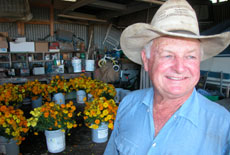Human Flower Project
Search Results for:Kew
Paul Mckinney Singing Through The Soil
By on February 28th, 2022 in
Thursday, September 03, 2009
Singing through the Soil
Allen Bush pays homage to one of his mentors—a Western North Carolina farmer who orchestrated crops and equipment, and sang gospel music, too.

Paul McKinney and his trusty 1949 Farmall tractor
Photo: Paula McKinney
By Allen Bush
Up Avery’s Creek and around Mills River in the North Carolina mountains, between Asheville and Hendersonville, folks love Paul McKinney. He is a good man, a remarkable man. He and his wife, Mary, own McKinney’s Small Fruits and have been partners in love for fifty-nine years. Paul is old school though not old-fashioned, except for his customary overalls. He stands tall, over six feet, a wise, handsome man who shakes hands as firmly as he strung barbed wire.
I lived a half-mile down the road from the McKinneys between 1979 and 1995. Paul came down to introduce himself soon after I arrived. It was the neighborly thing to do. I had bought 37 acres and started Holbrook Farm, named after my mother’s side of the family. They had come from Trap Hill, a few ridgetops away in Wilkes County. My retail mail-order nursery published a spring and fall catalog and shipped rare and unusual perennials across the country for fifteen years. I moved to the farm from Louisville, Kentucky, after a year’s training at the Royal Botanic Gardens at Kew, England. The summers were cooler and the winters milder in western North Carolina. I was a suburban boy turned nurseryman, full of myself, but actually not quite sure what I’d gotten myself into.
Mr. McKinney worshiped Jesus, loved his family and made no pretense. He drew no distinction between sinners and the saved. He was fair to everyone, especially his newly arrived, suspect, bearded neighbor. I was young, had some backing – the support of a family and new wife – and fell into the might-be-saved-someday category. Paul and Mary McKinney had bought a small place up the road, two years before I arrived. They had little financial backing but never lacked for loving family or devoted friends.
Mothers Remedies From Jamaicas Country
By on February 28th, 2022 in
Monday, November 15, 2010
Mother’s Remedies from Jamaica
It’s cold season. Georgia Silvera Seamans and baby Robert catch the bug and glean home remedies from grandmother. Fetch the cauldron…

A mobile for the baby’s room? No, it’s bitter melon (Momordica charantia), used in Jamaican traditional medicine to make a tea that eases stomach ache.
Photo: wiki
By Georgia Silvera Seamans
My baby’s ear infection went away without his taking antibiotics. Now, we both have colds. He is not being given anything for his cold except liquids and rest. I am gargling my sore throat with warm salt water per my mother’s instruction. This morning, after putting my baby to sleep, my mother told me about home remedies of her youth. My mother grew up “in the country” of Jamaica.
Fever
Pick a lot of fever grass (a.k.a. lemongrass), boil it in a large cauldron, pour the hot liquid into a tub, and set a wooden plank across the tub. The feverish person would then sit on the plank and be covered by a sheet. The person would remain under the steam sauna until the water became lukewarm. Prior to pouring the fever grass brew into the tub, a small portion would be sweetened with sugar or honey for the feverish person to drink.
Headache
As many cow-foot leaves (Piper umbellatum) as were needed to cover one’s head were gathered and then your head was wrapped with a scarf.
Makahiya
By on February 28th, 2022 in
Sunday, August 27, 2006
Makahiya— Shy Heroine of the Philippines
A blossom newly named for President Arroyo sets off fury in a land of flower legends.
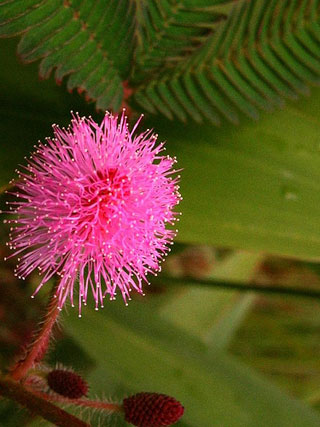
Makahiya: “Sensitive plant”
Photo: Maverick
Maybe because its countryside is so very lush, Philippine Island culture abounds with creation myths, legends that “remind us of our connection to nature. We have a lot of stories on the origins of flowers, like those of dama de noche, roses, ilang-ilang, sampaguita…” writes Norma Dollaga. “Listening to these stories, we are able to connect ourselves spiritually and ecologically with the gift of creation.”
Dollaga writes that, as in the rest of the world, “Most of these ‘alamat’ [myths] we grew up with are stories on the goodness or evil ways of people. Myths and legends remind us that when a person dies or disappears, an embodiment of that person will arise.”
If this sounds like mild-mannered folkloristics, think again. Dollaga’s op-ed piece for INQ7 is as pointed as pitchfork—she’s fuming that a flower has been named for Filipino president Gloria Macapagal-Arroyo. “Mussaenda Gloria Macapagal Arroyo,” honoring the controversial head of state, was bred by Dr. Teresita Rosario. “It fits the President. It is petite and cute,” Rosario said.
With the Islands’ old custom of turning flower legend into object lesson, how, Dollaga asks, “can a leader widely perceived as corrupt, fraudulent and a cheat be cute? Naming a flower after Ms Arroyo is a betrayal of the people and dishonors flowers. Flowers must be adored and respected. Dr. Rosario’s flower deserves better.”
 Seed packet for Mimosa pudica
Seed packet for Mimosa pudica
Source: Amaday
Dollaga then tells the story of Makahiya or “sensitive plant.” Once upon a similarly-corrupt time, bandits roamed the land. In one village lived a humble family, mother, father and their shy, virtuous girl, Maria. Eventually the band of thieves arrived and plundered their town, knocking the parents unconscious. When they awoke they looked for their precious daughter only to find Mimosa pudica, an odd new plant with firecracker-like blossoms. When touched, the plant drew its leaves together, as if to hide. They resolved that their dear and pure Maria had changed into this sensitive plant rather than surrender her virtue.
(The Makahiya story sounds a lot like the Greek myth of Daphne; she escaped the clutches of Apollo by turning into a laurel tree.)
With a bit of snooping, we’ve found a number of references to Makahiya, showing how dear this plant is to those who grew up in the Philippines. One young blogger writes, “I was five years old the last time I visited the Philippines, with my mom. Even though my memories of the trip are few, I do have one that has remained close to my heart: my mom showing me this magical plant called makahiya.
“This very small fern-like plant blossoms with numerous heads of pink and lavender flowers. When touched, as if by magic, the leaves close up onto themselves. My mother instructed me to touch this plant, and I remember very vividly seeing the leaves curl and close and giggling with glee as I ran around the garden looking for more. A few weeks ago, Tita Jo kindly invited me to her lovely little summer home in Antipollo (about one hour north of Quezon City). There in her garden she pointed out the makahiya plant. I again touched the leaves, and with just as much delight (if not more) I watched them curl and close up.”
Mimosa pudica is actually native to Brazil though it has spread over much of the tropics. Kinmatsu Lin posts several good photos and Maverick offers some etymological details. “Other names given to this curious plant are Humble plant, Shame plant, Sleeping grass, Touch-me-not, and Mori Vivi (West Indies). The Chinese name for this plant translates to ‘shyness grass.’ The species epithet, pudica, is Latin for ‘bashful’ or ‘shrinking.’”
And in Tagalog, the language of much of the Philippines, Makahiya means “shy”…certainly not the characteristic of a woman who would be president.
We share Norma Dollaga’s interest in legends and likewise think that the rampant naming of flowers for celebrities—whether shiny movie stars or shady politicians—slights our cultures and our flowers, too. At the same time, the feminist in us bristles. Why are these “female” plants of lore usually the shrinking, low-growing, delicate ones?
Ms. Dollaga, perhaps would you approve attaching “Gloria Macapagal Arroyo” to something tall, garish, prickly, or stinky?
Joe Pye Weed My Man
By on February 28th, 2022 in
Friday, July 29, 2011
Joe Pye Weed, My Man
It’s hotter than a boiled peanut! Time for the hard-core gardeners of the Mid-South—like Allen Bush—to show what they’re made of.
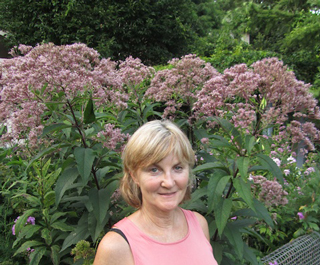
Joe Pye Weed (Eupatorium maculatum ‘Atropurpureum’)
stands tall in the July garden with Rose Cooper Bush
Louisville, Kentucky
Photo: Allen Bush
By Allen Bush
After two hours of weeding and planting in the sweltering morning heat, it’s usually time to throw in the towel. Well, not quite. I keep a towel handy to wipe the sweat off my creased brow and dab my receding hairline. This is one coping ritual for mid-summer. A cool swim later in the afternoon can work wonders, too. But the Lakeside temperature is hovering near 90 F (32 C). There’s no magic, there. When the morning temperature hits the low end at 80 F (27C), as the sun comes-up, you know you’re in for a rough ride the rest of the day. There’s no stopping 90 F (32 C) or hotter. During spells like this, when the humidity is as stifling as the debate on debt limits, it’s hard to catch a break.
July wasn’t hot straight the way through, and I wasn’t stuck in Kentucky all month, either. I caught a breather in the Colorado Rockies, with good friends, looking at alpine wildflowers in early July. My pals Kirk Alexander and Panayoti Keliaidis organized a great tour. I’d call home each day and Rose would tell me about the skyrocketing Louisville heat index that hovered in the triple digits for days. I tried to be sympathetic. The annoying heat index – a summer flogging by forecasters – combines ambient temperature with the relative humidity. But it doesn’t skewer “the hardware of reality.” It’s hot and we all know it.
I didn’t tell Rose I was wearing a cotton sweater at 10,000 on the road up to Pikes Peak. Nor did I dwell on walks through meadows in the alpine tundra filled with primroses and alpine forget-me-nots.
Iris Stocksii Your Day Is Coming
By on February 28th, 2022 in
Wednesday, June 23, 2010
Iris stocksii: Your Day Is Coming
Alpine horticulturists around the world, including Allen Bush, wait with excitement as cultivation of a rare Juno iris, collected in Afghanistan, begins.
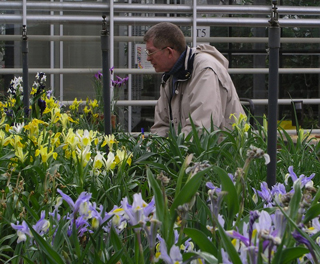
Tony Hall working on a frame of Juno Iris
Royal Botanic Gardens at Kew, 2009
Photo: Jim Almond
By Allen Bush
I spent one sleepless hour after another on my London flight in late May walking the aisle while staring at an unconscious planeload. I tried to play catch-up. Two glasses of airline wine and an Ambien didn’t do a bit of good. A day later I came calling on Tony Hall cross-eyed with jet lag. Sleep walking for a couple of hours around the Royal Botanic Gardens at Kew seems now like a dream—full of memories of a friend.
I tumbled out of the car on Kew Road at Primrose House and graciously agreed to be picked-up sooner or later. Later preferred. I feared sooner since neither Kew Gardens nor precious time with Tony Hall should be done on the fly. Hall has retired – sort of. He was for nearly thirty years the Manager of Kew’s Alpine Unit, caring the alpine plants and bulbs and overseeing the Alpine House and Woodland Garden. Hall, renowned for his knowledge of Iris, is the leading authority on Juno Iris and working toward a botanic monograph. Kew continues to provide facilities for Hall’s Juno Project.
Tony buzzed me in and was eager to get moving. A special package had just arrived: four bulbs and nearly fifty seeds of the very rare Iris stocksii.
In Lieu Of For Lady Bird Not Hardly
By on February 28th, 2022 in
Monday, July 16, 2007
‘In Lieu of’ for Lady Bird? Not Hardly!
Flowers poured in for the U.S. former first lady, tributes from the mighty and the more-than-meek. Do tell!

At the LBJ Library July 14, friends of Lady Bird Johnson
admired the many floral tributes—and their senders
All Photos: Anonymous
Reading through many obituaries of Lady Bird Johnson, we didn’t once catch sight of the phrase “in lieu of flowers….” Generous as she was to many organizations, notably the Wildflower Center that bears her name, Mrs. Johnson and her family didn’t see fit to discourage blooms as she was mourned and buried this weekend. What a relief and joy!
We weren’t among the guests invited to her private obsequies, but a friend of ours was. At a reception held on the 10th floor of the Lyndon Baines Johnson Memorial Library on Saturday, our friend took a look at the cards tucked in several of the arrangements (and pictures of some other folks doing the same thing). Our friend expressed a smidgen of embarrassment at having peeked at the names, but we assured him/her that such curiosity is only proper. So is spreading the word.
People who send ostentatious (or why don’t we call them “gorgeous”) floral arrangements to a funeral are doing a wonderful thing, and they’re rightfully inviting and deserving credit. In our view, it’s no different than someone with a powerful singing voice really opening up for a hymn. Isn’t there some good advice about not putting your light under a bushel? Likewise, we think, don’t put a sock in your mouth when it’s time to sing or refrain from sending flowers with your name on them to ANY occasion.
So, here are just a few of the many flower arrangements sent to honor Lady Bird Johnson (and to distinguish the givers a bit, too). Many thanks to our delightful and distinguished and discreet camera-toting friend.
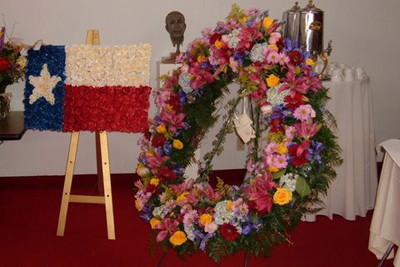
A floral Texas flag from ?? and wreath from pianist Van Cliburn
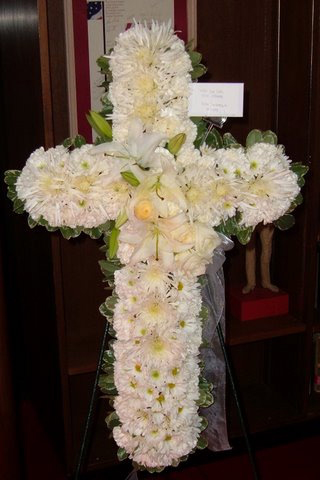
From the Rev. Billy Graham
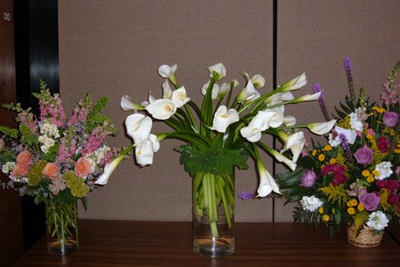
From (l-r) Betty Ford, the Reza Pahlavi family (Shah of Iran), and ??
Homecoming Mum The Riot On Your Chest
By on February 28th, 2022 in
Friday, October 20, 2006
Homecoming Mum: A Riot of Conformity
How to stick out, fit in, and drop $75 for the big game.

JV cheerleader Amani Dorn sold programs
at Lake Travis (TX) High School
Homecoming football game, 2002
Photo: Bill Bishop
Lake Travis High School JV cheerleader Amani Dorn looks down at her chest, powerless to explain what’s there. “I guess it’s based on the whole corsage thing.”
She’s wearing a silk bloom the size of a cauliflower, nestled in spangles and rigged with a fake butterfly. Two pounds of trinkets hang from red and silver ribbons down to her bare calves. This is no corsage. It’s a dead grouse crossed with a bottle rocket, a Texas homecoming mum.
Depending on your feeling for the boys-will-be-hideous sport of football—chin straps, ice packs and necks thick as thighs—the homecoming mum is either the mightiest incursion or the ghastliest concession girls have made, our turn to shine and groan. At the Lake Travis High School Homecoming last month just about all girls over age 12 and under 25 arrived with chestwear. Outside the stadium one fan, obviously a mum-novice, stepped cautiously, steadying herself on a boy’s arm and lifting her gush of ribbons to keep from tripping.
“You kind of get to show off,” said Lake Travis sophomore Ashton Verrengia, standing with an armload of programs by the main gate. Her mum sagged from two oversized pins, loaded with a panda bear, globular heart, cut-out of the state of Texas, even a car, since “I’m going to be driving this year.”
 Kira Miles, senior,
Kira Miles, senior,
with black and white mum
Permian High School homecoming
Odessa, Texas, 2003
Photo: Julie Ardery
Up in the stands, blonde and bronzed April Fields, also a sophomore, sported two gigantic mums, one a gift from her date, Brett Jennings, the other from friend Clayton Amacker, in the running that night for Homecoming King. Both her silk flowers bore Batman insignia because, she explained, “The theme is superheroes for homecoming.” April said “creativity” keeps driving the mum tradition to new extremes; to prove it, her two mums were studded with more symbols and cryptic allusions than a Renaissance altarpiece: “O” and “Pushpop” in silver lettering, a Batman yoyo and a soccer ball charm.
On Wednesday before the Lake Travis homecoming game, Glenda Morris, floral designer of the H.E. B. at Bee Caves Rd. and Hwy. 71, sounded edgy. “We’re booked solid. We can’t take any more orders.” Christy Cedeno, a clerk at the nearby Randall’s, said her floral department began preparing for mum season back in July. “We make them all summer long,” customizing each flower as orders flow in. Cedeno said her store had made over 150 silk mums for Lake Travis homecoming alone. Donna Parker, owner of Flowers by Nancy, Too in Lakeway, estimated she would fill 100 mum orders by game day, and “this year, we’ve added lights.”
Those raised in milquetoast states like Ohio or New York may think a homecoming mum is one white flower with a bow of your school colors and—oh, wow—a pipecleaner initial. Native Kansan Becky Swem, *with* flower wholesale house Pike’s Peak of Austin, remembers waiting on her first Texas high school cheerleader years ago, “I kept trying to convince her to get something else. She’s standing there in her little uniform and looking at me like I’m crazy. And I’m thinking, ‘Why does she want this huge mum and all this crap hanging off of it?’ ”
Why, indeed? Even old hands at mum-making, like designer Tom Blomquist of Bill Doran wholesale, aren’t sure, but he declares, “This is a Texas phenomenon. Nowhere else in the country is the football mum business like it is here in Texas.” As with most Lone Star excesses, the trail seems to lead toward College Station. Members of the Aggie corps used to buy their dates white chrysanthemums for every home game. Not to be outdone, the UT fans started wearing flowers, too, for the big Thanksgiving Day contest against arch rival A&M.
Hoya All I Want From Christmas
By on February 28th, 2022 in
Friday, September 01, 2006
Hoya—All I Want from Christmas
It’s Bird Week on Christmas Island; floral detours allowed.
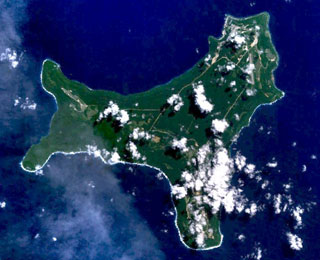
Christmas Island (the one in the Indian Ocean)
Photo: Earth from Space
Welcome to our newest visitors, from Christmas Island (pop. 1500).
Strange to find out you’re nowhere near the North Pole, but 360 km SW of Java, in the Indian Ocean. (Actually there are two Christmas Islands—the first a territory of Australia, the second one better known as Kiritimati, part of the Republic of Kiribati and likewise without igloos. It’s right near the Equator in the Pacific.)
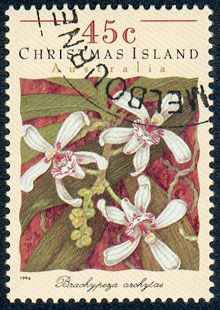
Of Christmas Island (Australia) 63% is protected land. This national park “contains the last remaining nesting habitat in the world of the endangered Abbott’s booby and also supports the world’s largest remaining robber crab population.” Christmas Island, in fact, claims to have the “most diverse land crab community anywhere.” This site has some fine shots of fauna and flora, including a number of those Cancerians.
There are some 411 plant species on Christmas Island. “18 of these are endemic” and about 125 have been found nowhere else in Australia or its other territories. “28 species are currently considered rare or threatened” including several orchids and the marvelous Hoya aldrichii, its flowers a cluster of waxy stars more dazzling than any holiday ornament.
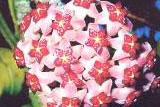 Hoya aldrichii
Hoya aldrichii
Photo: Christmas Island National Park
We weren’t familiar with the Hoyas (except, of course, through Georgetown University athletics). And if they’re new to you make sure to take a look at these flowers via the International Hoya Society. They remind us a bit of Rubik’s cubes—Rubik’s globes, if you will. Here’s one to make reindeer fly: Hoya Publicalyx featured last month in Daniel Mosquin’s knockout Botany Photo of the Day (which makes every day Christmas).
For a bit more on the political history of Christmas Island check here.
Bird Week on the island begins today and should be merry. If you’re in the vicinity, put down your egg nog and go help “biologist Janos Hennicke attach tiny tracking devices” to Abbott’s boobies. And please send us a hoya flower photo, too.
Her Honor For A Potato Crop
By on February 28th, 2022 in
Saturday, May 26, 2012
Her Honor for a Potato Crop
Should a community garden director be free to hawk her Olympic torch?

Route of the Olympic Torch, May 26, 2012
Image: London Olympics 2012
Sarah Milner Simonds was honored by the Olympic committee to carry the Olympic torch along part of its route to the 2012 summer games. Simonds, a 38-year-old horticulturist, was chosen for her work with People’s Plot, “a community allotment in South Acton [West of London], where we can grow our own fruit and vegetables, cook and eat the food we grow together.”
But before Simonds ever trotted her segment of the Olympic relay, her honor was besmirched: she had tried to sell her torch on ebay.
According to the New York Times, the winning bidder offered 153,100 pounds, ($242,323) last Sunday, meanwhile drawing down the fury many observers – though the unnamed buyer has yet to pay up.
Simonds defended her position, saying she intended to plow all proceeds from the sale back into People’s Plot: “There are still lots of people who feel strongly that these iconic torches are somehow sacred and that trading demeans their value,” Simonds said. “To these I would ask how exactly can we plant our potatoes using a torch? They obviously didn’t understand my motives.”
Several other torchbearers likewise have tried or are now trying to sell their Olympic flame-carriers, and most of them too have designated specific charities as beneficiaries.
Are honorifics transferable commodities? There are plenty of Olympic medals up for sale on ebay right now. Does it matter that Simonds didn’t win her torch, rather that it was conferred upon her by the Olympic committee? Since she didn’t have to toss a shot put farthest or run fastest for it, does that make the object any less hers to do with as she pleases, or more so? Do her charitable motives make a difference?
The American Academy of Motion Pictures Sciences confronted the problem back in 1950, after a trade in Oscars has begun. In 1950 the Academy began binding winners to an agreement banning them or their heirs “from selling their Oscars to anyone but the Academy for the nominal sum of $1.”
Academy Awards made prior to 1950 are exempt. Michael Jackson bought the 1939 Best Picture Oscar, awarded to “Gone with the Wind,” for $1.54 million in 1999. Other less renowned statuettes, all awarded pre-1950, have sold at auction too.
Give Me Land Lots Of Land
By on February 28th, 2022 in
Friday, September 05, 2008
‘Give Me Land, Lots of Land…’
Flower farming, a venture with promise in Africa, is stagnating in many nations as “land reform” runs aground. And there are other high hurdles ahead.
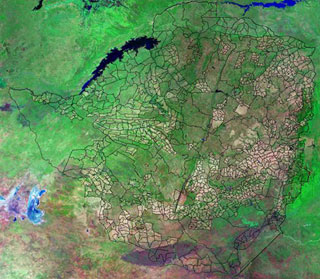
Zimbabwe lands
Source: FAS/USDA
As recently as twenty years ago, Africa’s flowers were minor leaguers in the global flower market. That’s not so today, as Kenya (principally) but now also Ethiopia and more southerly African countries plow ahead. They hope to best South America and China by likewise capitalizing on sunshine, cheap labor and open land.
But whose land is it? Confusion and, in some nations, violence over that question have made flower farming enormously risky business. Brigitte Weidlich’s story of a cut flower operation in Namibia is fresh, and representative. She writes of the Wiese family’s 90 year old farm, Ongombo West near Windhoek, which once “exported arum lilies to the Netherlands worth several millions of Namibia dollars annually.”
In 2004, it was the first farm to be expropriated by the Namibian government, after a labor dispute. The white owners had to relinquish their rights to the property. In the years since, according to Weidlich’s report, the farm has been idle; “all infrastructure, including the large green houses for the defunct flower export business, has deteriorated.” Six “erstwhile farmers” who were resettled there to work the land have had to hire out on neighboring farms. And now the national Ministry of Lands has posted a want ad, hoping to attract “experienced and reputed engineering companies for the assessment of rehabilitation required for existing irrigation infrastructure.”
A Namibian official calls the situation at Ongombo West “a delicate issue”—another way of saying “big flat flop.”
